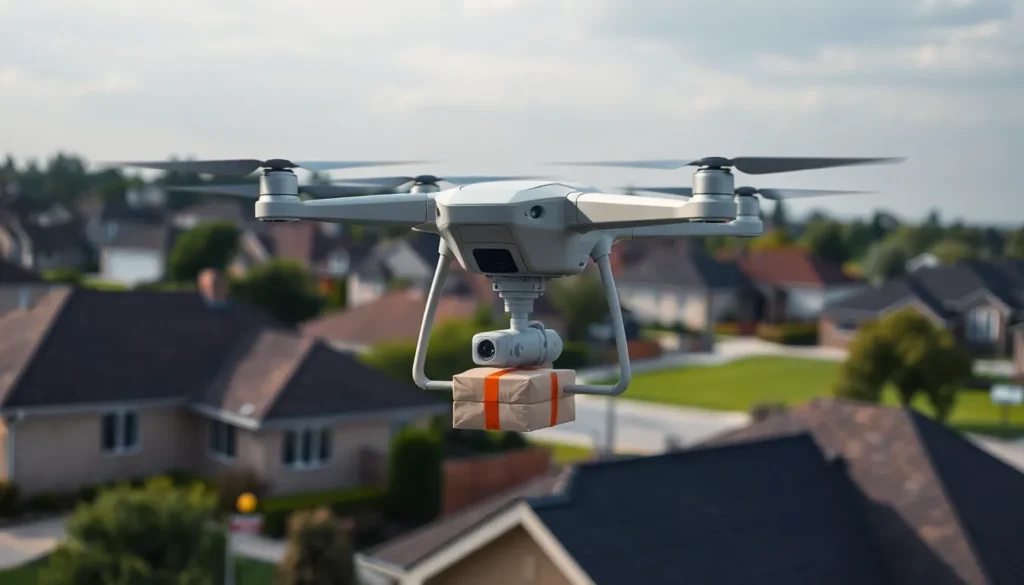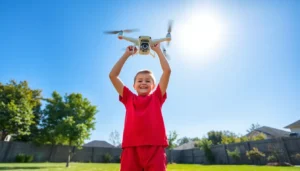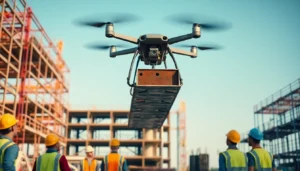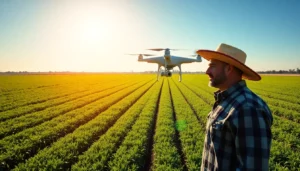Table of Contents
ToggleImagine a world where your pizza arrives before you can say “extra cheese.” Enter the age of drones that can carry things, revolutionizing delivery as we know it. These flying wonders aren’t just for aerial photography or spying on neighbors; they’re the future of transporting goods with speed and efficiency.
From medical supplies reaching remote areas to your online shopping arriving at your doorstep in record time, drones are set to change the game. They promise to take the heavy lifting off our hands—literally. So buckle up as we explore how these high-flying helpers are making life easier, one delivery at a time. Who knew that the future of logistics would involve tiny robots zipping through the skies while we sit back and relax?
Overview of Drones That Can Carry Things
Drones designed for carrying items excel in various industries, ranging from logistics to agriculture. These aerial devices transport everything from small packages to larger cargo efficiently. Payload capacities often vary, with many consumer drones supporting loads of up to 5 pounds, while industrial models can carry upwards of 200 pounds.
Several key players dominate the market in cargo-carrying drones. Companies like Zipline focus on medical deliveries, utilizing drones to transport supplies to remote areas. Amazon’s Prime Air aims to deliver retail products swiftly within 30 minutes. Meanwhile, DJI offers models that cater to filmmakers and photographers, who often require drones that can carry heavy cameras and equipment.
Technological advancements enhance the performance of these drones. Innovations in battery life, navigation systems, and payload management optimize their utility. For instance, some drones now feature autonomous flight capabilities, enabling them to navigate complex environments without human intervention. Many also incorporate safety features, such as obstacle avoidance and fail-safe systems, which ensure secure operations during flights.
Regulatory frameworks impact the operational landscape for drones that carry things. Agencies like the Federal Aviation Administration (FAA) establish rules governing airspace use, affecting how and where these drones can operate commercially. Compliance with regulations is vital for businesses aiming to leverage this technology fully.
The future of cargo-carrying drones promises even more growth. Enhanced connectivity, AI integration, and ongoing research in materials will likely expand their reach. As technologies evolve, the potential for delivering goods directly to consumers will transform logistics and supply chains, enabling a more efficient and responsive system.
Types of Drones That Can Carry Things
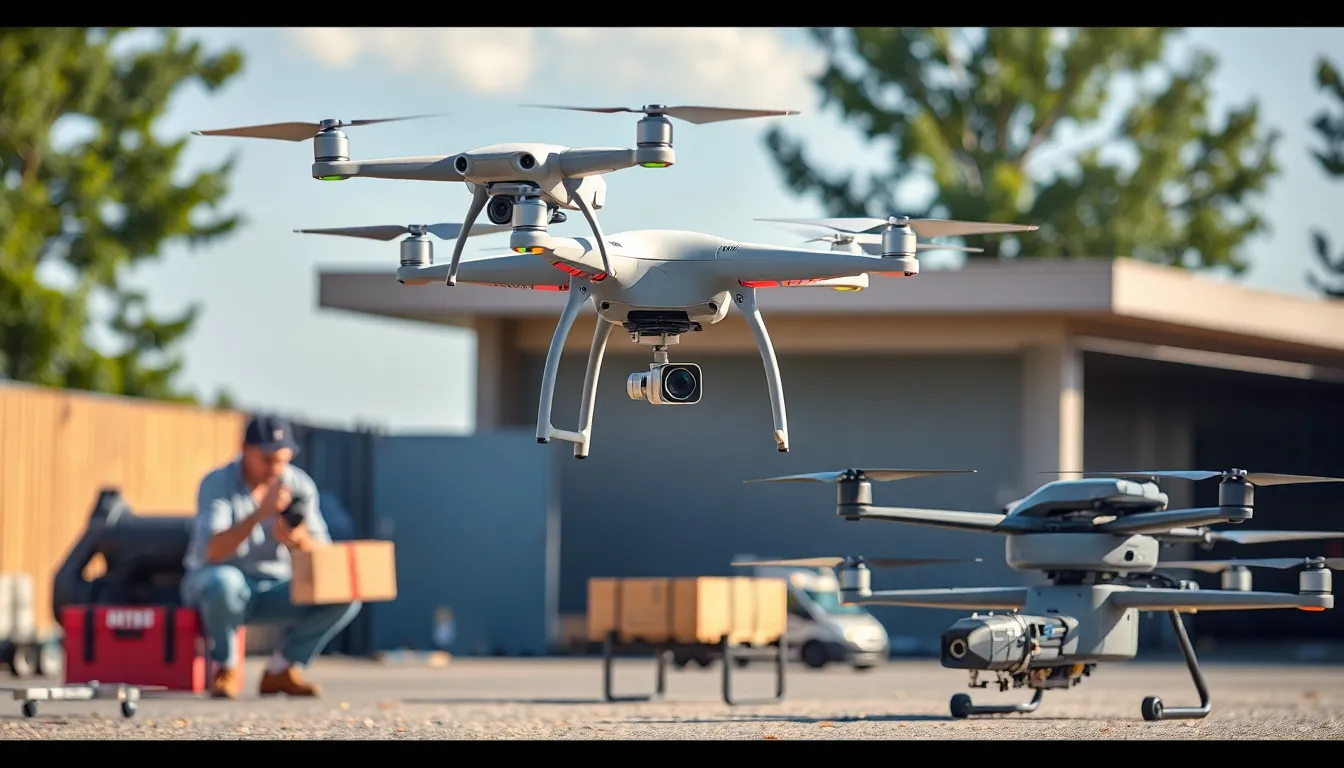
Drones capable of carrying items come in various types, each serving distinct needs and industries. These categories include consumer drones, commercial drones, and industrial drones.
Consumer Drones
Consumer drones typically have payload capacities up to 5 pounds, making them suitable for personal use. These drones often assist in photography and recreational activities, providing users with an opportunity to transport lightweight cameras and small items. Popular models in this category include the DJI Mini series, known for their portability and ease of use. Users appreciate how these devices enhance aerial experiences, allowing for creative projects without significant investment.
Commercial Drones
Commercial drones cater to businesses requiring reliable delivery solutions. Payload capacities generally range from 10 to 50 pounds, depending on the model. These drones are instrumental in industries like retail and agriculture, enabling efficient distribution of goods and monitoring crop health. Companies such as Amazon Prime Air and Flytrex use commercial drones for delivering products rapidly, fulfilling consumer demand for quick service. Organizations leverage these drones to streamline operations and improve customer satisfaction.
Industrial Drones
Industrial drones stand out for their ability to carry payloads exceeding 200 pounds, making them essential tools in heavy-duty applications. They serve sectors like construction and mining, delivering equipment and materials to hard-to-reach locations. Models like the Griff Aviation 400 and DJI Matrice 600 showcase advanced capabilities for transporting significant loads safely. Organizations implementing industrial drones benefit from increased efficiency and reduced operational costs, reshaping logistics in various industries.
Applications of Drones That Can Carry Things
Drones designed for carrying items find applications across various sectors. Their versatility enhances efficiency and effectiveness in multiple tasks.
Delivery Services
Delivery services benefit immensely from drones. Companies like Zipline and Amazon utilize these flying devices for swift parcel transportation. Drones reduce delivery times significantly, often completing routes in minutes instead of hours. With payload capacities of up to 5 pounds for consumer models and over 200 pounds for industrial variants, these drones cater to different delivery needs. Urban areas, where traffic congestion hampers traditional delivery methods, gain particular advantage from aerial logistics.
Agriculture and Farming
Agriculture employs drones for various purposes. Many farmers use them for monitoring crops and delivering supplies, like seeds and fertilizers. These drones can carry payloads ranging from 10 to 50 pounds, allowing efficient distribution of essential resources. Crop health assessment through high-resolution imaging offers invaluable insights, helping optimize yield. Technology trends point towards increasing adoption of this method, as agricultural drones improve productivity while minimizing labor costs.
Search and Rescue Operations
Search and rescue missions increasingly rely on drones. These devices offer aerial support during emergencies, enabling rapid transportation of medical supplies and equipment. Drones assist in locating individuals in hard-to-reach areas, enhancing response times. Payload capabilities allow for carrying essential items weighing over 200 pounds, making them essential during natural disasters. Integrating drone technology into rescue operations improves coordination and efficiency, ultimately saving lives during critical situations.
Benefits of Using Drones That Can Carry Things
Drones that can carry items offer numerous advantages across various sectors. Speed ranks high among these benefits, with drones delivering goods in a fraction of the time required by traditional methods. Precision delivery further enhances efficiency, allowing packages to reach specific destinations without unnecessary handling.
Cost reduction emerges as another key benefit. Businesses save on labor and transportation expenses, making operations more financially viable. Increased accessibility follows closely, particularly in remote or hard-to-reach areas where conventional delivery methods may struggle.
Environmental impact matters as well. Drone use reduces carbon footprints by minimizing reliance on vehicles that contribute to pollution. Enhanced safety is another advantage, as drones can safely transport medical supplies in emergency situations, eliminating risks posed by human messengers.
Flexibility in operations cannot be overlooked either. Drones easily adapt to varied payload capacities, serving diverse industries from medical to construction. Furthermore, their capability to operate without direct supervision makes them invaluable in dangerous environments, reducing risk to human workers.
Data integration and analytics provide additional benefits. Drones equipped with sensors collect real-time data, allowing businesses to optimize routes and inventory management. Enhanced customer experience results from speedy deliveries and accurate tracking, fostering loyalty and repeat business.
Overall, the versatility and operational efficiency of drones that can carry items position them as essential tools in modern logistics and various industries, ensuring services respond effectively to consumer demands.
Challenges and Limitations
Drones that carry items face various challenges impacting their widespread adoption. Payload weight restrictions often limit efficiency. For example, consumer drones typically support loads up to 5 pounds, while industrial models can carry over 200 pounds. Many operators encounter regulatory hurdles, as agencies like the FAA establish guidelines that govern flight paths, airspace, and delivery distances.
Battery life presents another significant challenge. Drones with extended flight times are essential for transporting larger payloads, yet most consumer models can operate for only 20 to 30 minutes. Limited battery capacity directly affects delivery range and frequency. Weather conditions also play a critical role in drone operations, as high winds and rain can hinder performance and safety.
Infrastructure for charging and landing drones remains insufficient in many areas. Ground facilities may not accommodate regular drone traffic, delaying logistics operations. Moreover, cybersecurity threats pose risks to data integrity. Ensuring secure transmission of sensitive information becomes paramount in commercial and industrial applications.
Public perception influences the development of drone technology as well. Concerns about privacy and noise pollution arise, causing resistance among communities. The integration of drones into existing transportation networks requires careful consideration to avoid congestion and inefficiencies.
Cost implications serve as an additional barrier for many businesses. Acquiring and maintaining advanced drone technology demands financial investment, which may not align with all organizations’ capabilities. Training staff to operate drones safely and effectively can further exacerbate these costs, placing added pressure on resources.
Despite these challenges, ongoing advancements in technology and regulation slowly mitigate limitations. Companies continually work towards solutions that enhance drone capabilities and address these issues, creating more opportunities for growth across various sectors.
Future Trends in Drone Technology
Innovations in drone technology continue to shape the transportation landscape. Enhanced battery life significantly improves operational efficiency, allowing longer flight times and greater ranges for deliveries. Advanced AI systems enable autonomous navigation, streamlining flight paths and minimizing human intervention.
Increased payload capabilities represent a critical development, particularly for industrial applications. Recent models designed for logistics can carry upwards of 500 pounds, which broadens their usage in heavy-duty scenarios.
Moreover, connectivity advancements play a vital role in drone operations. Real-time data transmission enhances route optimization and inventory management, benefitting sectors like retail and agriculture.
Regulatory changes set forth by the FAA promote positive industry growth. These frameworks ensure safer integration of cargo-carrying drones into national airspace, fostering public trust and industry confidence.
Environmental considerations also accelerate the adoption of drone technology. Reduced reliance on traditional vehicles lowers carbon emissions while improving delivery efficiencies in urban environments.
Collaboration between key industry players enhances overall capabilities. Companies like Zipline and Amazon continue to push boundaries, driving innovation and creating effective delivery solutions that meet consumer demands.
Finally, ongoing research into drone swarm technology holds potential for future applications. Coordinated flights among multiple drones could revolutionize logistics, enabling faster, more efficient delivery systems across diverse sectors.
Drones that can carry items are reshaping the logistics landscape across various industries. Their ability to deliver goods quickly and efficiently is already making a significant impact. As technology continues to advance and regulatory frameworks evolve, the potential for drones to enhance supply chains and improve accessibility grows.
While challenges remain, such as payload limitations and battery life, ongoing innovations are paving the way for broader adoption. The future promises even greater capabilities with increased payload capacities and enhanced connectivity. As companies invest in this technology, the benefits of faster deliveries and reduced environmental impact will likely become even more pronounced, solidifying drones’ role as essential tools in modern logistics.

